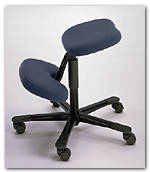Main Menu · Search ·Current Issue ·Contact ·Archives ·Centennial ·Letters to the Editor ·FAQs
 The much-imitated Balans Chair "makes it natural to lean forward with a straight back," according to Håg.Courtesy Håg |
Chairs even have a social life. Many seem to travel in herds, like the curious little gilt ones that are toted from one society event to another, or they exist in stacks, like communally nesting swallows or purple martins.
 In the Fogg Museum exhibit for the Day Without Art, commemorating AIDS victims, chairs represent solidarity and individuality, and promise continuity. The exhibit was the idea of staff member Danielle Hanrahan. Photograph by Joe Wrinn |
Chairs are not only gregarious creations; they are even human surrogates. Like the prophet Elijah's reserved seat at the Passover Seder (in a few Avignonese synagogues it is even mounted in wall niches) or the "Vacant Chair" representing the faraway soldier in the American Civil War song, a chair turns the missing into the present. For millions of visitors to the National Museum of American History, Archie and Edith Bunker's chairs are Carroll O'Connor and Jean Stapleton. On a more sinister note, at the 1993 murder trial in absentia of the Philadelphia guru Ira Einhorn, an empty defendant's chair was retained. Above all, the chair is a memorial, a common gravestone image of the nineteenth century. The patriarchal Puget Sound industrialist John S. McMillan even memorialized himself and his family as a set of chairs around a dinner table.

Yet chairs can stand for social disorder as well as order. A chair lying on its side in a painting or print like Hogarth's Marriage la Mode is a convention for a disordered life. The familiar eighteenth-century English political ceremony of "chairing the member" was curiously followed by the violent dismemberment of the victorious candidate's temporary throne--mere animal spirits or an unsubtle reminder of the crowd's ability to unmake power? Indeed, in more recent popular culture the chair is a potent weapon that can at least plausibly keep a circus lion at bay, not to mention furnish the cast of a classic Hollywood Western with matériel for a photogenic brawl. And for contemporary artists it can be a sinister place in its own right: an installation by the video sculptor Tony Oursler features a man's face, delivering a recorded religious harangue, projected onto a doll lying beneath an overturned chair.
Chairs remain potent emblems both of human variety and of common fate in our own time. Photographs of a handful of chairs in the street have represented conflagration and survival in modern Lebanon and Bosnia. In 1989, the artist Alexis Smith and the poet Amy Gerstler presented an exhibition of five dozen children's chairs accompanied by enigmatic epitaphs: "a lesson in mortality," as the critic Richard Armstrong put it. And in the same year the staff of Harvard's Fogg Museum commemorated colleagues, family members, and friends who had died of AIDS (and those living with the disease)
 Doug Fitch '81 demonstrates his version of radical reclining. Designed in a sophomore tutorial at Harvard, the chair flips over for prone reading and may be stood on end as sculpture. Courtesy Doug Fitch |
In our presence, as well as in our absence, we lend our character to our chairs. When we drape a jacket on a chair, or leave a hat on it, we even start to clothe it. As the historian Leora Auslander has written in her new book, Taste and Power, choosing a chair can mean reconciling conflicting values within one's own family, and even negotiating a new self-definition: "[Guests] respond with their interpretations of my chair and me. I respond and am changed by their responses. I have been made by that chair and I have made the chair."
To return to the physical, as opposed to metaphorical, chair, it is equally a double agent. The chair arranges our bodies for presentation. In doing so, it promotes our public selves, but it often oppresses our bodies. In his book Home, the architect Witold Rybczynski has, correctly of course, deplored the dysfunctional consequences of the modernist aesthetic in furniture. And it does seem hypocritical that the Bauhaus school, which exalted industrial efficiency, should have produced structures like Mies van der Rohe's Barcelona Chair, with its concave back, thin cushions, and massive weight, or Marcel Breuer's Wassily Chair, a cubist exercise in chromeplated tubing and leather straps that provide even less support. (Its inspiration was reportedly the designer's bicycle handlebars.) Not that the deep cushions of Le Corbusier's misnamed Grand Comfort Armchair are a satisfactory alternative, however inviting its form might seem.